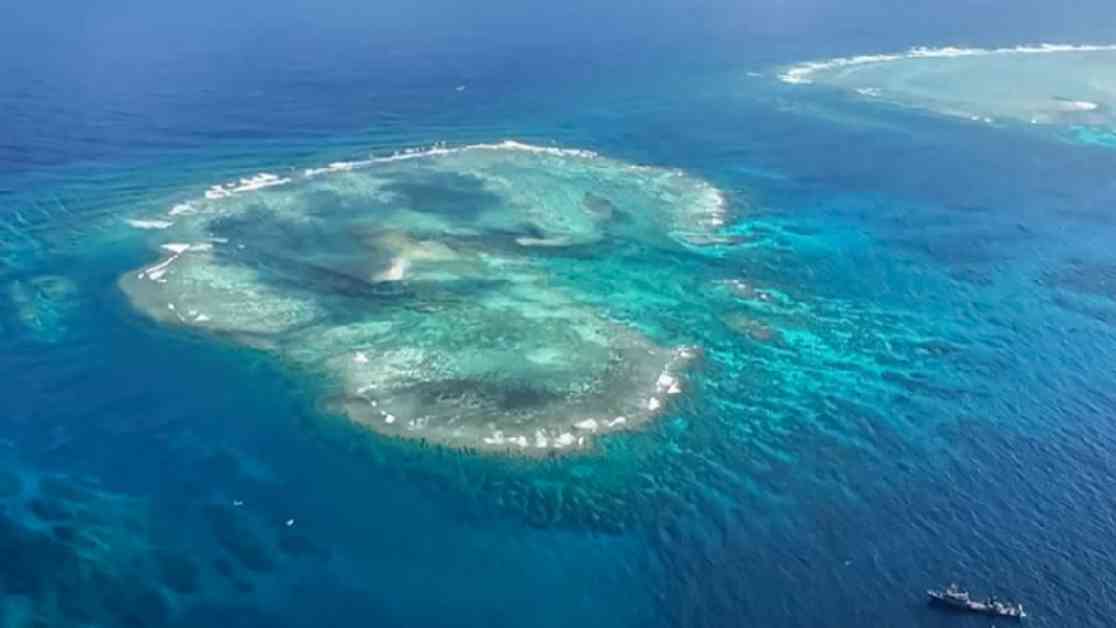China Coast Guard (CCG) has issued a strong warning to the Philippines, urging them to withdraw their coast guard ship that is currently anchored in Xianbin Jiao of China’s Nansha Qundao. The CCG spokesperson, Gan Yu, emphasized the urgency of the situation and stressed that the Philippines must cease any attempts to replenish the vessel, which is in violation of Chinese territory.
Gan Yu revealed that the Chinese side had been closely monitoring the Philippine Coast Guard ship 9701, as a Philippine H-145 helicopter was seen airdropping supplies to the vessel on Wednesday. This incident is just one in a series of actions taken by Manila that China perceives as an infringement on their territory under the guise of humanitarian aid. Gan expressed grave concerns about the potential risks involved in such actions, warning that they could easily lead to accidents at sea and in the air.
The CCG spokesperson highlighted that the Philippine vessel is fully functional and capable of independently leaving and returning to a Philippine port at any time. Therefore, the continued presence of the ship in Chinese territory is both unnecessary and provocative. Gan emphasized that the Philippines must immediately cease all risky actions and withdraw the ship on its own accord to avoid any further escalation of tensions in the region.
China asserts its indisputable sovereignty over Nansha Qundao, including Xianbin Jiao, and the adjacent waters. Gan reiterated that the CCG is on high alert and fully prepared to safeguard China’s territorial sovereignty and maritime rights and interests. The Chinese authorities are adamant in their stance that any consequences arising from the Philippines’ actions will be solely the responsibility of the Philippine government.
According to CCG reports, the Philippine Coast Guard vessel, designated as 9701, entered the lagoon of Xianbin Jiao without permission and has remained there since April. This unauthorized presence is a clear violation of China’s territorial integrity and has sparked tensions between the two nations.
Philippines’ Response and Justification
In response to China’s demands, the Philippines has defended its actions by stating that the presence of their coast guard ship in the area is necessary for humanitarian purposes. Manila argues that the vessel is providing assistance to Filipino fishermen who have been facing difficulties at sea. The Philippines maintains that their actions are in line with international laws and conventions regarding humanitarian aid and the safety of seafarers.
However, China has firmly rejected the Philippines’ justifications, labeling them as a pretext for encroaching on Chinese territory. The CCG has accused the Philippines of exploiting humanitarian concerns to advance their own agenda in the disputed waters. This clash of narratives has intensified the tensions between the two countries and raised concerns about the potential for a maritime conflict in the region.
International Arbitration and Territorial Disputes
The territorial disputes in the South China Sea, including the Nansha Qundao region, have been a longstanding issue in international relations. Multiple countries, including China, the Philippines, Vietnam, Malaysia, and Taiwan, have overlapping territorial claims in the area, leading to frequent tensions and confrontations.
In 2016, an international tribunal ruled in favor of the Philippines in a case brought against China over territorial disputes in the South China Sea. The tribunal invalidated China’s claims to historic rights in the waters and found that Beijing had violated the Philippines’ sovereign rights by constructing artificial islands in the region. However, China rejected the ruling, asserting that it would not comply with the decision.
The arbitration ruling did little to resolve the underlying territorial disputes in the South China Sea, as both China and the Philippines continued to assert their claims in the region. The presence of foreign vessels and military assets in the disputed waters has only heightened the tensions and raised concerns about the potential for a military conflict in the area.
Regional Stability and Diplomatic Solutions
The escalating tensions between China and the Philippines in the Nansha Qundao region pose a significant threat to regional stability and security. The South China Sea is a strategic waterway through which trillions of dollars in trade pass annually, making it a crucial economic and geopolitical hotspot. Any conflict or disruption in the region could have far-reaching implications for global trade and security.
Diplomatic efforts to de-escalate the tensions and find a peaceful solution to the territorial disputes have been ongoing. The Association of Southeast Asian Nations (ASEAN) has played a key role in facilitating dialogue between the parties involved and promoting a rules-based approach to resolving the disputes. However, the complex nature of the territorial claims and the strategic interests at stake have made it challenging to achieve a lasting resolution.
As the situation in the Nansha Qundao region continues to escalate, the international community is closely monitoring the developments and urging all parties to exercise restraint and refrain from any actions that could further inflame the situation. The need for diplomatic engagement and dialogue remains paramount in order to prevent any potential conflict and maintain peace and stability in the South China Sea.

















